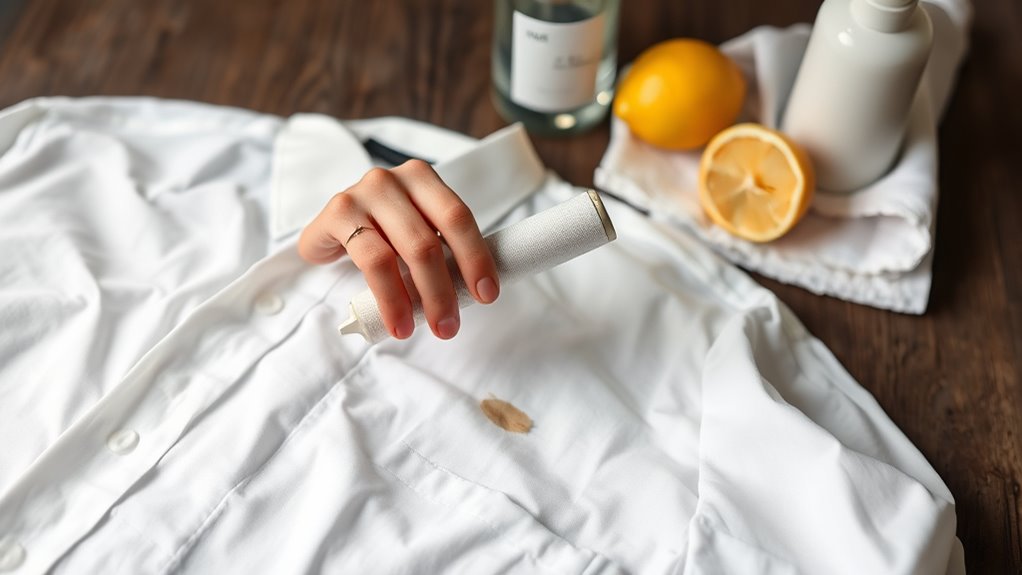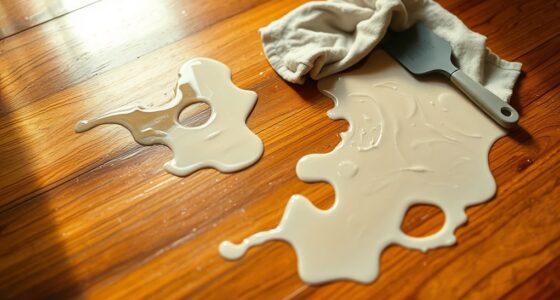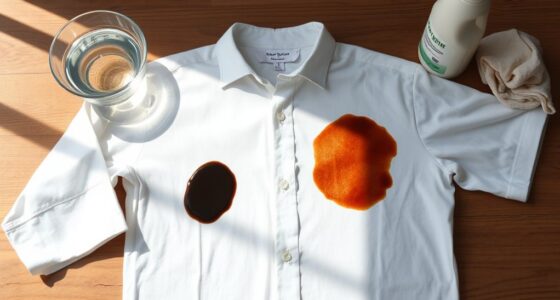To get rid of deodorant marks on shirts, act quickly! Rub the fabric against itself to loosen residue. Use a dry cloth to absorb moisture, then apply a baking soda paste for best results. Household items like white vinegar or lemon juice can also help dissolve stains. To prevent future marks, always let your deodorant dry fully before dressing. Want to know more effective tips and tricks for tackling stubborn stains?
Key Takeaways
- Rub the fabric against itself to loosen and lift the deodorant residue effectively.
- Use a used dryer sheet to wipe away white streaks on dark fabrics.
- For delicate fabrics, gently dab with nylon stockings to remove fresh marks.
- Apply a baking soda paste or soak in a vinegar-water solution for stubborn stains.
- Always act quickly, as fresh stains are easier to remove than set stains.
Immediate Action for Fresh Stains
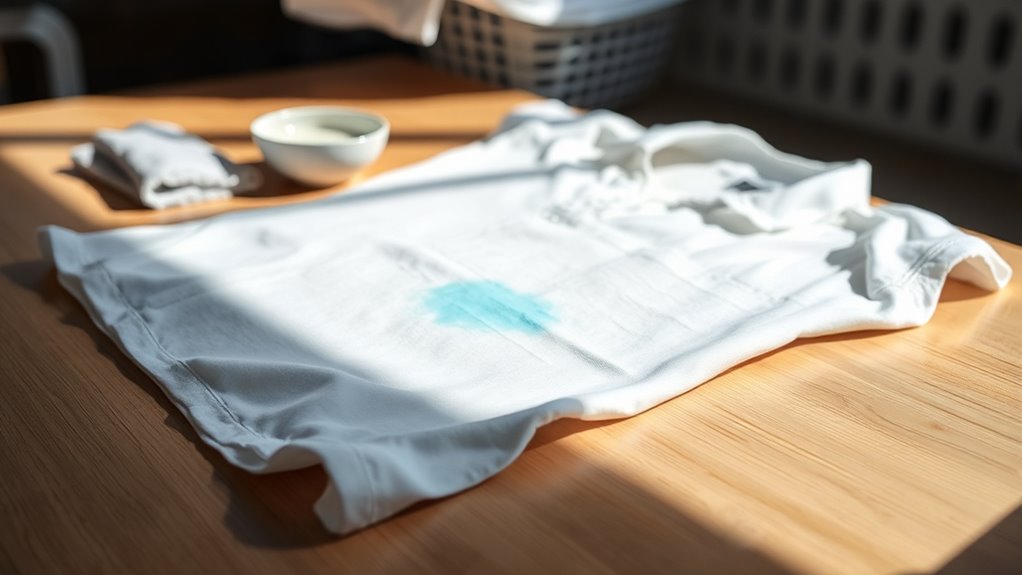
When you notice fresh deodorant stains on your shirt, acting quickly can make all the difference in removing them.
Start by rubbing the fabric against itself to loosen the residue. If you have a used dryer sheet on hand, that can help, too; just rub it over the stain to eliminate white streaks without adding more residue.
For dark fabrics, pantyhose or stockings work wonders in gently removing marks. Quick dabbing with a dry cloth can absorb excess moisture and prevent the stain from setting. Additionally, using baking soda to create a paste can effectively neutralize the stain when applied after the initial treatment.
After treating the stain, launder the garment promptly to prevent discoloration and maintain fabric integrity.
The sooner you tackle those stains, the easier they’ll be to remove and the less hassle your laundry will be!
Household Items for Effective Removal
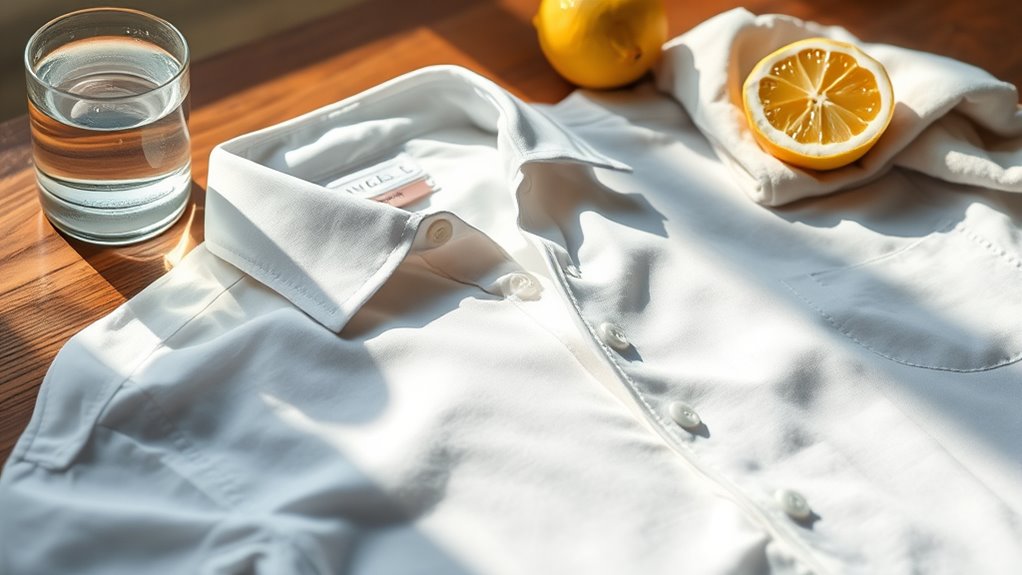
To effectively tackle deodorant marks on your shirts, you can utilize common household items that pack a punch against stains. Baking soda’s mild abrasiveness scrubs away the marks, while white vinegar dissolves residue effectively. Using nylon stockings can be a quick and effective method for removing fresh marks without damaging the fabric.
For light-colored fabrics, lemon juice offers a natural bleaching effect. If you’re dealing with whites, hydrogen peroxide works well but should be avoided on darker fabrics. You can also use nylon stockings to gently rub away fresh streaks.
For the best results, soak stained areas in a vinegar-water solution or create a baking soda paste to apply directly. Remember to let treated areas air dry after using these solutions to guarantee maximum effectiveness in removing those stubborn stains.
Preventive Strategies to Avoid Stains

Preventing deodorant stains on your shirts starts with a few simple strategies that can save you from frustration later.
First, make sure your deodorant is completely dry before you get dressed. Choose stain-minimizing or aluminum-free formulas to reduce discoloration. Also, apply just enough deodorant; using excess can lead to residue on your clothing. Additionally, trimming or shaving your armpit hair can help minimize sweat retention and reduce the risk of stains.
Wearing sweat-proof undershirts acts as a protective barrier between your deodorant and outer shirts. After wearing, wash your shirts immediately to prevent buildup.
Finally, avoid applying deodorant after dressing. These strategies not only keep your shirts looking fresh but also save you time and effort on stain removal later.
Implement these tips, and you’ll enjoy a cleaner wardrobe.
Types of Fabrics Prone to Marks
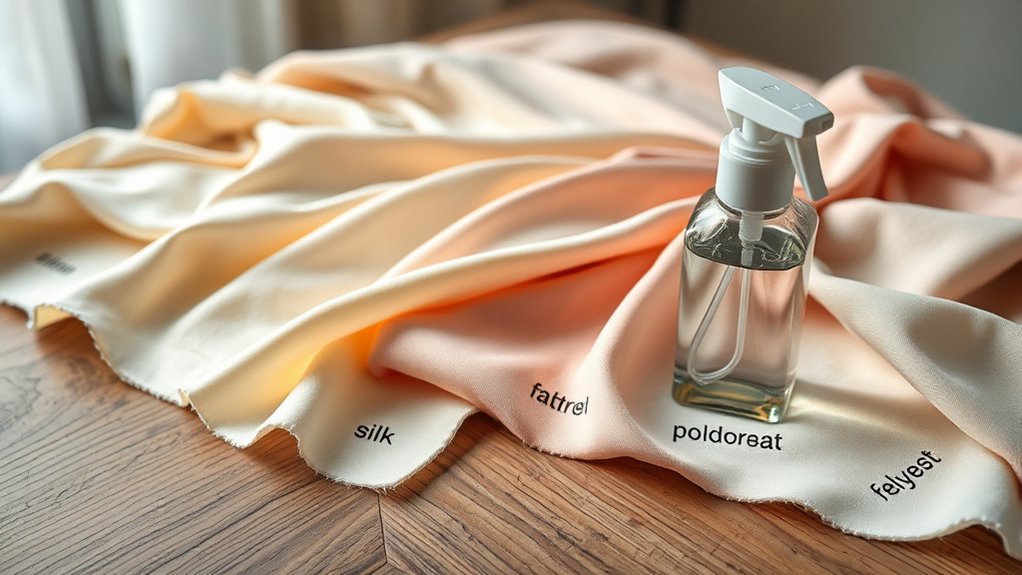
Even with the best preventive strategies in place, some fabrics are more prone to deodorant marks than others.
Synthetic fibers like nylon, spandex, and polyester often attract stains due to their moisture-wicking properties and texture. Commercial deodorant mark removal products can be particularly effective on these fabrics to help combat stubborn marks.
Cotton blends can also be problematic, especially those with synthetic components that trap waxy residues.
Light-colored fabrics, regardless of material, display stains more visibly.
Delicate materials like silk and wool are particularly susceptible to discoloration from stain removal attempts.
Stretchy fabrics, commonly found in activewear, often show marks due to tight fits and friction.
Knowing these fabric types can help you make better choices when selecting clothing to minimize deodorant marks.
Best Practices for Stain Removal
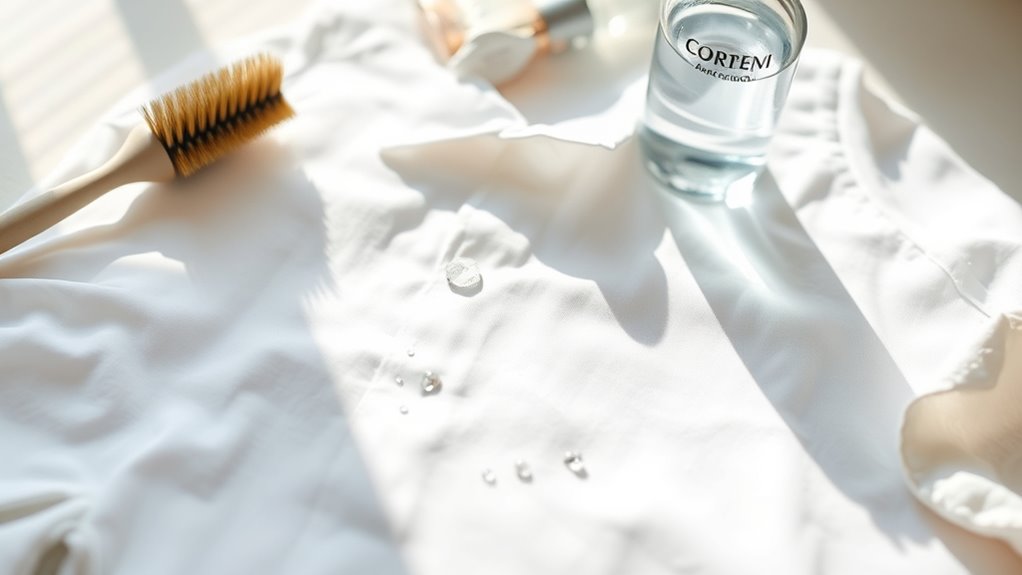
When it comes to tackling deodorant marks on your shirts, acting quickly is key; fresh stains are much easier to remove than those that have set in. Start with gentle methods, like a baking soda paste or white vinegar, to avoid damaging the fabric. Pre-treat stains by applying a stain remover directly to the mark for better results. Deodorant stains can appear as white marks or discoloration, particularly on dark fabrics, making it essential to address them promptly. Additionally, using necessary cookies on websites can help enhance your browsing experience while you look for cleaning solutions. Avoid harsh chemicals like bleach, as they can ruin your clothing; opt for alternatives like hydrogen peroxide or enzyme-based cleaners instead. Always test any cleaning solution on a hidden area first. Regular cleaning with efficient filtration systems can also help maintain fabric quality and prevent buildup that leads to stains. Maintaining air quality in your home can also help reduce allergens that may exacerbate skin issues leading to deodorant marks.
Frequently Asked Questions
Can Deodorant Stains Be Removed From Delicate Fabrics Like Silk?
Yes, you can remove deodorant stains from delicate fabrics like silk, but you need to be gentle.
Start by rinsing the stained area with ice-cold water to loosen the stain.
Then, apply a diluted mixture of white vinegar and water, or sprinkle some salt on the stain before rinsing again.
If the stain persists, consider consulting a professional cleaner to avoid damaging the silk.
Always treat stains promptly for the best results.
What Are the Best Deodorants to Prevent Stains on Clothing?
When you’re looking for the best deodorants to prevent stains on clothing, consider options like clear gel or spray formulas.
Brands like Dove Men+Care Stain Defense and Degree Men UltraClear Black + White are great choices. They’re designed to minimize both white and yellow stains.
Remember to apply a thin layer and let it dry before dressing. This way, you can stay fresh without worrying about unsightly marks on your favorite clothes.
How Do I Remove Deodorant Stains From Upholstery or Furniture?
To remove deodorant stains from upholstery, start by scraping off any excess residue.
Lay a towel over the stained area and apply heat with a hot iron to melt and absorb the deodorant.
Repeat this with clean towels until no residue remains.
Alternatively, you can freeze the stain using compressed air and scrape the residue away.
Always test any method on a hidden area first to guarantee it won’t damage your fabric.
Is It Safe to Use Bleach on All Types of Fabrics?
Imagine standing in front of a closet, deciding which fabric to wear, only to wonder if bleach is your friend or foe.
It’s not safe to use bleach on all fabrics. Cotton can handle it, but wool and silk? They’ll suffer. Polyester may yellow, while linen can weaken with repeated exposure.
Always test a small area first, and remember, dilute bleach according to instructions to keep your clothes looking fresh and vibrant.
How Can I Avoid Deodorant Residue on My Skin?
To avoid deodorant residue on your skin, start by exfoliating regularly to remove dead skin cells.
Use mild soaps to cleanse your underarms and keep them moisturized.
Apply antiperspirant at night on completely dry skin to enhance effectiveness.
Be careful not to overapply and consider products designed for sensitive skin to minimize irritation.
Finally, wear loose clothing to reduce friction and help prevent residue build-up.
Conclusion
Now that you’re armed with these tips, you can say goodbye to those pesky deodorant marks lurking on your shirts like unwelcome guests. With a little quick action, some household magic, and a dash of prevention, your wardrobe will shine like a sunlit morning. Remember, fabric choice plays a role, and knowing the right techniques will keep you looking fresh and confident. Embrace these strategies, and let your style soar without the shadow of stains!
